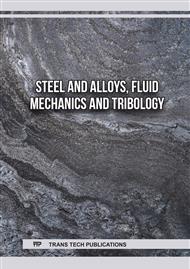[1]
M.N. Alam, A.N. Siddiquee, Z.A. Khan, Machining of ZrO2 using wire EDM: an experiment based investigation via assisted electrode, Advances in Materials and Processing Technologies 10:4 (2024) 3473-3490.
DOI: 10.1080/2374068x.2023.2247284
Google Scholar
[2]
Z. Anwer, J. Vleugels, A. Datye, S. Zhang, S. Huang, Influence of varying carbon content in (V, Nb, Ta, Ti, W) C high entropy carbide-Ni based cermets on densification, microstructure, mechanical properties and phase stability, Ceramics International 49:3 (2023) 4997-5012.
DOI: 10.1016/j.ceramint.2022.11.121
Google Scholar
[3]
M. Dhanunjay, A.S. Reddy, M. Madduleti, Study on mechanical properties of AMMC and optimization of WEDM process parameters, Manufacturing Technology Today 22:9-10 (2023) 10-26.
DOI: 10.58368/mtt.22.9-10.2023.10-26
Google Scholar
[4]
L. Ďaková, M. Hrubovčáková, A. Kovalčíková, D. Medveď, J. Andrejovská, F. Kromka, Ľ. Medvecký, J. Dusza, Influence of sintering condition on tribological properties of (Hf-Ta-Zr-Nb-Ti) C carbides, International Journal of Refractory Metals and Hard Materials 119 (2024) 106549.
DOI: 10.1016/j.ijrmhm.2023.106549
Google Scholar
[5]
C. Hu, C. Chen, J. Sun, S. Wei, Y. Du, K. Pan, H. Yu, J. Tao, Comparison of the microstructure and mechanical properties of WC-Ti (C, N)-Ni gradient cemented carbides prepared by SPS pre-sintering and vacuum pre-sintering, Journal of Materials Research and Technology 26 (2023) 7213-7223.
DOI: 10.1016/j.jmrt.2023.09.073
Google Scholar
[6]
E. Kantoríková, J. Moravec, V. Biňasová, The effect of borides on the mechanical properties of tool steels and sintered carbides, Transportation Research Procedia 74 (2023) 522-529.
DOI: 10.1016/j.trpro.2023.11.177
Google Scholar
[7]
S. Kosaraju, P. Babu Bobba, S.R. Salkuti, Optimization and microstructural studies on the machining of Inconel 600 in WEDM using untreated and cryogenically treated zinc electrodes, Materials 16 (2023) 3181.
DOI: 10.3390/ma16083181
Google Scholar
[8]
A. Kopytowski, R. Świercz, D. Oniszczuk-Świercz, J. Zawora, J. Kuczak, Ł. Żrodowski, Effects of a New Type of Grinding Wheel with Multi-Granular Abrasive Grains on Surface Topography Properties after Grinding of Inconel 625, Materials 16 (2023) 716.
DOI: 10.3390/ma16020716
Google Scholar
[9]
W. Ming, X. Guo, G. Zhang, S. Hu, Z. Liu, Z. Xie, S. Zhang, L. Duan, Optimization of process parameters and performance for machining Inconel 718 in renewable dielectrics, Alexandria Engineering Journal 79 (2023) 164-179.
DOI: 10.1016/j.aej.2023.07.075
Google Scholar
[10]
M. Mhadhbi, İ.E. Dağ, B. Avar, M. Khitouni, M.A. Bousnina, F. Schoenstein, N. Jouini, Manufacturing of Novel Nanostructured TiCrC Carbides Using Mechanical Alloying and Spark Plasma Sintering, Metals 13:6 (2023) 1040.
DOI: 10.3390/met13061040
Google Scholar
[11]
T. Mohanraj, G. Sakthivel, A. Pramanik, Use of RSM desirability approach to optimize WEDM of mild steel, Physica Scripta 99:10 (2024) 105976.
DOI: 10.1088/1402-4896/ad7707
Google Scholar
[12]
K. Mouralova, L. Benes, T. Prokes, R. Zahradnicek, J. Fries, T. Plichta, Analysis of the machinability of different types of sintered carbides with WEDM in both water and oil baths, Int. J. Adv. Manuf. Technol. 125 (2023) 2705-2715.
DOI: 10.1007/s00170-023-10913-4
Google Scholar
[13]
S. Nosewicz, P. Jenczyk, B. Romelczyk-Baishya, P. Bazarnik, D. Jarząbek, K. Majchrowicz, Z. Pakieła, K. Kowiorski, M.Chmielewski, The influence of spark plasma sintering on multiscale mechanical properties of nickel-based composite materials, Materials Science and Engineering: A 891 (2024) 146001.
DOI: 10.1016/j.msea.2023.146001
Google Scholar
[14]
A. Nino, H. Takahashi, T. Sekine, S. Sugiyama, Effects of Si3N4 addition on the microstructure and mechanical properties of binderless tungsten carbides, International Journal of Refractory Metals and Hard Materials 114 (2023) 106267.
DOI: 10.1016/j.ijrmhm.2023.106267
Google Scholar
[15]
D. Oniszczuk-Świercz, R. Świercz, Š. Michna, Evaluation of prediction models of the microwire edm process of Inconel 718 using ANN and RSM methods, Materials 15 (2022) 8317.
DOI: 10.3390/ma15238317
Google Scholar
[16]
A. Panda, V. Chernobrovchenko, K. Dyadyura, L. Sukhodub, M. Kumeda, M. Behun, Selection of materials hydroxylapatite using the method of analysis of hierarchy, MM Science Journal, 6 (2023) 6472-6477.
Google Scholar
[17]
S.M. Rafiaei, M. Hadi, F. Fernandes, Synthesis of (Ti, W, Mo) CN based cermets with different carbides configurations for demanding applications: Study of the crystal structure, microstructure, and mechanical properties, Ceramics International 50:13 (2024) 23264-23274.
DOI: 10.1016/j.ceramint.2024.04.050
Google Scholar
[18]
M. Rimar, J. Kizek, A. Varga, M. Fedak, G. Jablonský, The influence of hydrogen concentration in natural gas on heat flows in a thermal aggregate, MM Science Journal, 12 (2022) 6162-6168.
Google Scholar
[19]
Ľ. Straka, M. Gombár, A. Vagaská, P. Kuchta, Efficiency Optimization of the Electroerosive Process in μ-WEDM of Steel MS1 Sintered Using DMLS Technology, Micromachines 13 (2022) 1446.
DOI: 10.3390/mi13091446
Google Scholar
[20]
J. B. Saedon, N. Jaafar, R. Jaafar, N.H. Saad, M.S. Kasim, Modeling and multi-response optimization on WEDM Ti6Al4V, Applied mechanics and materials 510 (2014) 123-129.
DOI: 10.4028/www.scientific.net/amm.510.123
Google Scholar
[21]
L. Straka, G. Dittrich, Influence of tool steel properties on surface quality after electrical discharge machining by wire electrode, International journal of advanced manufacturing technology 106:5-6 (2020) 1617-1632.
DOI: 10.1007/s00170-019-04708-9
Google Scholar
[22]
A. Vagaská, M. Gombár, Ľ. Straka, selected mathematical optimization methods for solving problems of engineering practice, Energies 15 (2022) 2205.
DOI: 10.3390/en15062205
Google Scholar



